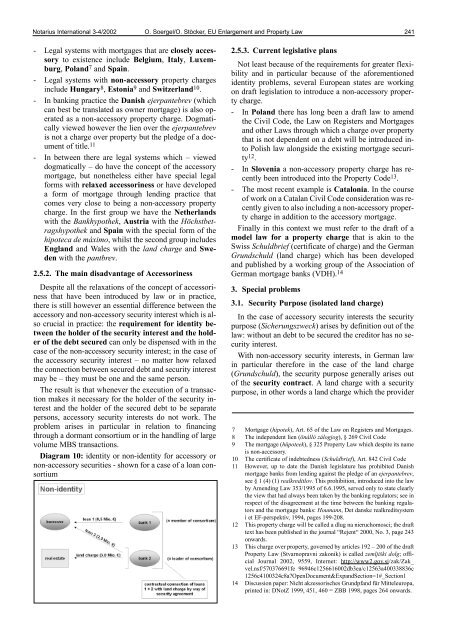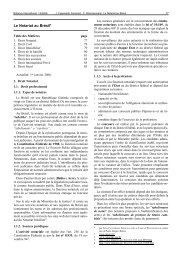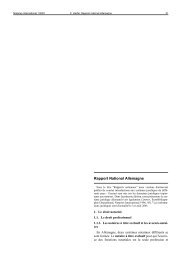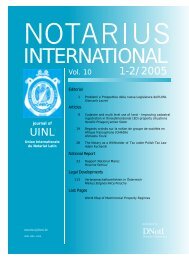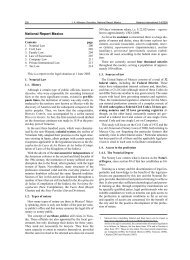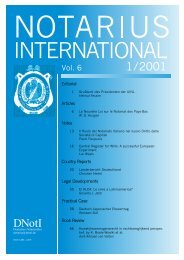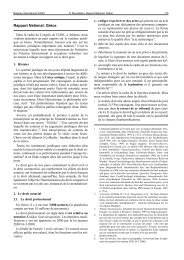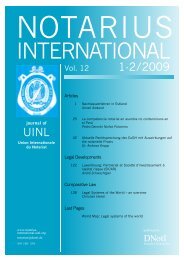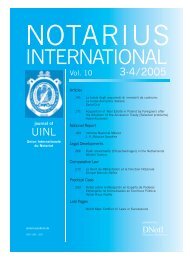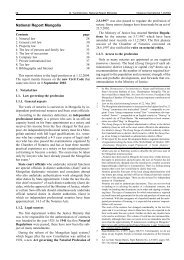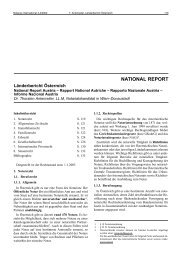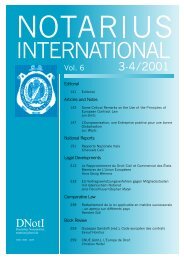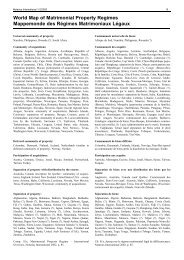ARTICLES and NOTES - Notarius International
ARTICLES and NOTES - Notarius International
ARTICLES and NOTES - Notarius International
Create successful ePaper yourself
Turn your PDF publications into a flip-book with our unique Google optimized e-Paper software.
<strong>Notarius</strong> <strong>International</strong> 3-4/2002 O. Soergel/O. Stöcker, EU Enlargement <strong>and</strong> Property Law 241<br />
- Legal systems with mortgages that are closely accessory<br />
to existence include Belgium, Italy, Luxemburg,<br />
Pol<strong>and</strong> 7 <strong>and</strong> Spain.<br />
- Legal systems with non-accessory property charges<br />
include Hungary 8 , Estonia 9 <strong>and</strong> Switzerl<strong>and</strong> 10 .<br />
- In banking practice the Danish ejerpantebrev (which<br />
can best be translated as owner mortgage) is also operated<br />
as a non-accessory property charge. Dogmatically<br />
viewed however the lien over the ejerpantebrev<br />
is not a charge over property but the pledge of a document<br />
of title. 11<br />
- In between there are legal systems which – viewed<br />
dogmatically – do have the concept of the accessory<br />
mortgage, but nonetheless either have special legal<br />
forms with relaxed accessoriness or have developed<br />
a form of mortgage through lending practice that<br />
comes very close to being a non-accessory property<br />
charge. In the first group we have the Netherl<strong>and</strong>s<br />
with the Bankhypothek, Austria with the Höchstbetragshypothek<br />
<strong>and</strong> Spain with the special form of the<br />
hipoteca de máximo, whilst the second group includes<br />
Engl<strong>and</strong> <strong>and</strong> Wales with the l<strong>and</strong> charge <strong>and</strong> Sweden<br />
with the pantbrev.<br />
2.5.2. The main disadvantage of Accessoriness<br />
Despite all the relaxations of the concept of accessoriness<br />
that have been introduced by law or in practice,<br />
there is still however an essential difference between the<br />
accessory <strong>and</strong> non-accessory security interest which is also<br />
crucial in practice: the requirement for identity between<br />
the holder of the security interest <strong>and</strong> the holder<br />
of the debt secured can only be dispensed with in the<br />
case of the non-accessory security interest; in the case of<br />
the accessory security interest – no matter how relaxed<br />
the connection between secured debt <strong>and</strong> security interest<br />
may be – they must be one <strong>and</strong> the same person.<br />
The result is that whenever the execution of a transaction<br />
makes it necessary for the holder of the security interest<br />
<strong>and</strong> the holder of the secured debt to be separate<br />
persons, accessory security interests do not work. The<br />
problem arises in particular in relation to financing<br />
through a dormant consortium or in the h<strong>and</strong>ling of large<br />
volume MBS transactions.<br />
Diagram 10: identity or non-identity for accessory or<br />
non-accessory securities - shown for a case of a loan consortium<br />
2.5.3. Current legislative plans<br />
Not least because of the requirements for greater flexibility<br />
<strong>and</strong> in particular because of the aforementioned<br />
identity problems, several European states are working<br />
on draft legislation to introduce a non-accessory property<br />
charge.<br />
- In Pol<strong>and</strong> there has long been a draft law to amend<br />
the Civil Code, the Law on Registers <strong>and</strong> Mortgages<br />
<strong>and</strong> other Laws through which a charge over property<br />
that is not dependent on a debt will be introduced into<br />
Polish law alongside the existing mortgage security<br />
12 .<br />
- In Slovenia a non-accessory property charge has recently<br />
been introduced into the Property Code 13 .<br />
- The most recent example is Catalonia. In the course<br />
of work on a Catalan Civil Code consideration was recently<br />
given to also including a non-accessory property<br />
charge in addition to the accessory mortgage.<br />
Finally in this context we must refer to the draft of a<br />
model law for a property charge that is akin to the<br />
Swiss Schuldbrief (certificate of charge) <strong>and</strong> the German<br />
Grundschuld (l<strong>and</strong> charge) which has been developed<br />
<strong>and</strong> published by a working group of the Association of<br />
German mortgage banks (VDH). 14<br />
3. Special problems<br />
3.1. Security Purpose (isolated l<strong>and</strong> charge)<br />
In the case of accessory security interests the security<br />
purpose (Sicherungszweck) arises by definition out of the<br />
law: without an debt to be secured the creditor has no security<br />
interest.<br />
With non-accessory security interests, in German law<br />
in particular therefore in the case of the l<strong>and</strong> charge<br />
(Grundschuld), the security purpose generally arises out<br />
of the security contract. A l<strong>and</strong> charge with a security<br />
purpose, in other words a l<strong>and</strong> charge which the provider<br />
7 Mortgage (hipotek), Art. 65 of the Law on Registers <strong>and</strong> Mortgages.<br />
8 The independent lien (önálló zálogjog), § 269 Civil Code<br />
9 The mortgage (hüpoteek), § 325 Property Law which despite its name<br />
is non-accessory.<br />
10 The certificate of indebtedness (Schuldbrief), Art. 842 Civil Code<br />
11 However, up to date the Danish legislature has prohibited Danish<br />
mortgage banks from lending against the pledge of an ejerpantebrev,<br />
see § 1 (4) (1) realkreditlov. This prohibition, introduced into the law<br />
by Amending Law 353/1995 of 6.6.1995, served only to state clearly<br />
the view that had always been taken by the banking regulators; see in<br />
respect of the disagreement at the time between the banking regulators<br />
<strong>and</strong> the mortgage banks: Houmann, Det danske realkreditsystem<br />
i et EF-perspektiv, 1994, pages 199-208.<br />
12 This property charge will be called a dlug na nieruchomosci; the draft<br />
text has been published in the journal “Rejent“ 2000, No. 3, page 243<br />
onwards.<br />
13 This charge over property, governed by articles 192 – 200 of the draft<br />
Property Law (Stvarnopravni zakonik) is called zemljiški dolg; official<br />
Journal 2002, 9559, Internet: http://www2.gov.si/zak/Zak_<br />
vel.nsf/570376691fe 96946c1256616002db3ea/c12563a400338836c<br />
1256c4100324c8aOpenDocument&Exp<strong>and</strong>Section=1#_Section1<br />
14 Discussion paper: Nicht akzessorisches Grundpf<strong>and</strong> für Mitteleuropa,<br />
printed in: DNotZ 1999, 451, 460 = ZBB 1998, pages 264 onwards.


